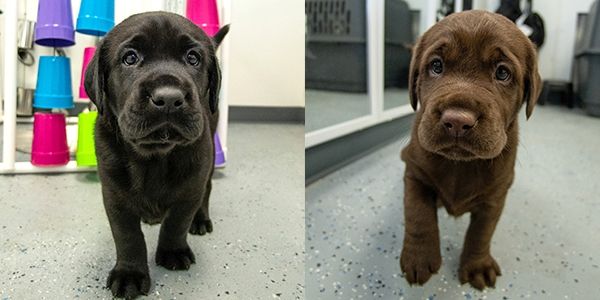Psychology professor helps identify best dogs for Vapor Wake program

The need for security continues to grow in all facets of American life, and Auburn University is meeting those needs with experts in cyber security, public safety, crisis management, and odor detection technology. While many of our experts are of the human variety, there are some of the canine variety, too.
Training a dog to become a specialized odor detection expert requires large investments of time and expense. The Canine Performance Sciences (CPS) program in the College of Veterinary Medicine at Auburn University conducts research and development to enhance the use of dogs for detection. A component of the CPS research mission investigates how to breed and raise the very best dogs for detection tasks. The dogs produced by CPS go through rigorous testing, conditioning and training to become Vapor Wake® (VW) dogs. VW is an Auburn University patented method for detecting person-borne explosives by dogs trained to sample odors from the aerodynamic wakes of moving persons (vapor trail) and track an explosive odor to its source. An essential part of becoming a certified VW dog involves being able to concentrate on detecting target odors amidst the distractions of crowded, noisy, and smelly urban venues such as mass transit, sports stadiums, and concert/event arenas. However, not every dog “graduates” from the VW training which ends up being a tremendous loss of resources. Preventing that loss is where psychology comes into play.
“One of the things we're very much interested in is developing an endophenotype, which is basically looking at behavior and looking at the brains in these dogs to see if we can find predictors early on in their training that will tell us who is going to be a premier dog, a successful dog. And what dog is not going to be. This is helpful in identifying not only the best dogs, but also as a cost-saving measure since training these dogs costs thousands of dollars,” said Jeffrey Katz, a professor in the Department of Psychological Sciences at Auburn University. Katz worked with his graduate students, Andie Thompkins and Lucia Lazarowski, and Gopi Deshpande, an electrical engineering professor from the College of Engineering, to identify brain patterns in dogs to use as predictors of success for the CPS program.
Part of assessing the dogs thought processes involved showing the dogs photos of their trainers and photos of strangers that varied in emotional content while measuring their responses.
“The dogs lie on their stomach in the scanner, and while they're remaining still, just like you do with humans, you have a projector screen that sits in the back of the bore, which is the opening where you have your scan done. You're presenting stimuli at certain times, and you're controlling it. And the dogs would look at these pictures that we collected. And then we'd look to see where the differences were in the brain. And we found some really interesting things,” Katz said.
“Dogs can tell the difference between familiar and unfamiliar faces. And they do vary in what parts of the brain respond to the emotional content. There's an area of the human brain in the temporal cortex that is responsive to faces. It's also true in non-humans such as rhesus macaques (monkeys), and it's true in sheep. So there’s this area of the brain that processes faces, and dogs have it too,” Katz said.
Outside of the MRI scanner, working with CPS, the team of researchers assessed 146 candidate detector dogs from the VW breeding and training program. Dogs received identical puppy development and foundational odor training and underwent performance evaluations at 3, 6, 10, and 12 months old. In this study, they found that by 10 months the Vapor Wake® dogs “express higher overall levels of hunt, focus, possession, independence, and work effort” than dogs not able to obtain the Vapor Wake status.
From pigeons to puppies
Katz is no stranger to studying the behavioral patterns of animals. When he began working for Auburn in 2000, he was developing tasks in concept learning across different species—primarily pigeons, monkeys, and humans.
“I had the pigeon lab and the funding was becoming more difficult to obtain. Around that time, I had students that were very much interested in working with dogs,” Katz said. “Canine research has really taken off over the last 15, 20 years. I call it the rise of the dogs,” he added.
Among those students was a graduate student named Andie Thompkins, who worked with Katz to develop and build an apparatus to measure concept learning in dogs.
“Building on some of the other projects I had done with all the other animals, we decided to look at dogs. Andie worked with a local vet hospital and got some space there to work with some of the dogs, and that kind of put it all together. That was our first step into canine research,” Katz said. “From there, she got really interested in wanting to do imaging, neuroimaging with non-humans, particularly with dogs. And who doesn’t want to work with puppies, right?”
While Thompkins conducted the canine research, Katz gravitated towards the Magnetic Resonance Imaging (MRI) Research Center. “I developed a really great relationship with Tom Denney, the director at the Auburn MRI Center. I became involved in a bunch of different projects, one having to do with soldiers with post-traumatic stress disorder and concussions. And that's taken my career to a lot of really interesting and novel places. And I’m still doing that work,” Katz said.
To learn more about the Katz's research, listen to his podcast interview.






